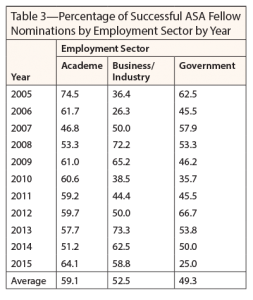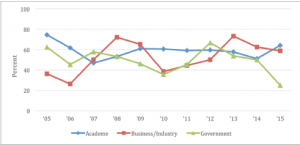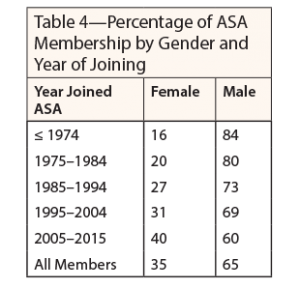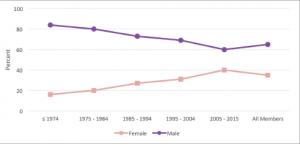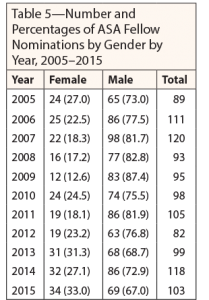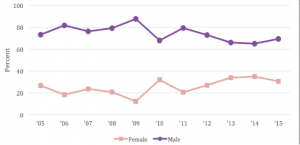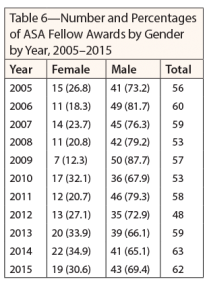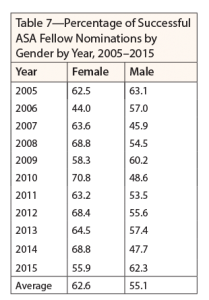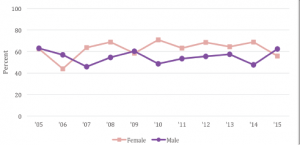The ASA Fellow Award 2015 Update
Stephanie Shipp, Chair, ASA Committee on Fellows
The ASA’s 62 new fellows were honored August 11 during the Joint Statistical Meetings in Seattle, Washington. The new fellows are from 24 U.S. states, the District of Columbia, and six other countries. Fellows are recognized for outstanding professional contributions to and leadership in statistical science. See the Amstat News October issue for a list of the new ASA fellows.
The fellows committee is composed of nine members, with three each from academia, government, and industry. Committee members serve a three-year term. Starting in early March every year, each member of the committee begins to read the applications, assigns their individual scores, and submits the scores to the chair. The chair normalizes the individual scores and then ranks the applicants by the average score. This provides a starting point for the discussion when the committee meets in April to select the fellows.
This article continues the tradition of providing a descriptive analysis of the ASA fellows and adds data for the 103 nominees and 62 fellows in 2015. Data are presented by employment sector and gender.
(Click on the tables and figures to enlarge them)
Employment Sector
In 2015, the percentage of ASA members in each employment sector was 55% academe, 35% business/industry, and 10% government. The number of ASA fellow awards given by employment sector for the most recent 11 years is presented in Table 1 and Figure 1. In 2015, 81% of the new fellows are from academe, 16% are from business/industry, and 3% are from government.
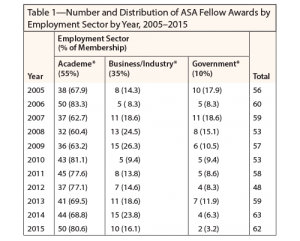
*Distribution of membership in 2015; 26% of members do not identify their employment sector on the ASA’s demographic information form.
ASA fellows are recognized for their accomplishments. To be honored, nominees must have established a reputation in the profession and made outstanding contributions to statistical science. The Committee on Fellows evaluates candidates’ contributions to the advancement of statistical science—requiring evidence of their innovation, leadership, and impact—and their contributions to the profession and society at large. Under ASA bylaws, the Committee on Fellows can elect up to one-third of one percent of the membership as fellows each year.
The percentages of fellows awarded by employment sector relative to the percentages of ASA membership are shown in Figure 2, which shows that academics are nominated at a higher rate and business/industry members are nominated at a consistently lower rate relative to their respective proportions of membership. Government nomination rates have fluctuated the most in relative terms, in part due to the smaller proportion of members.
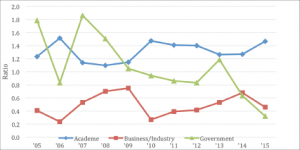
Figure 2: Percentage of fellows awarded by employment sector relative to the percentage of ASA membership in that sector by year
The yearly number and percentage of fellow nominations in each employment sector are shown in Table 2. The 103 nominations received in 2015 are close to the average of 101 nominations submitted between 2005 and 2015. The number and percentage of nominations from academe remained high in 2015, while both the number and percentage of nominations from government were low.
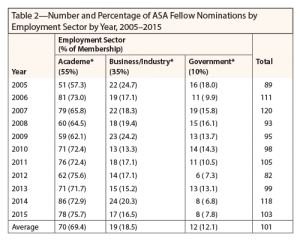
*Distribution of membership in 2015; 26% of members do not identify their employment sector on the ASA’s demographic information form.
One question of continuing interest is the rate of success for the nominations in each sector. As shown in Table 3 and Figure 3, the success rate of nominations submitted from the government sector was below average in 2015. The success rate for academe and business/industry was above average in 2015.
Gender
Table 4 and Figure 4 show the current ASA membership by gender and year of joining the ASA (or, if membership lapsed, rejoining the ASA). The summary is based on available data; more than 15% of ASA members do not enter their gender on their membership form. Among the current members who provide data, there is an increasing trend over time in the proportion of female members.
The number and percentage of ASA Fellow nominations by gender in each year from 2005 through 2015 are presented in Table 5. The number and percent of female nominations have varied since 2005, with a slight increase in recent years.
The number and percentage of ASA fellow awards from 2005 through 2015 are presented by gender in Table 6, and the percentages are charted in Figure 5. There has been a slight decline in the percentage of males and slight overall increase in females, although the numbers and percentages vary each year.
Among nominees, the chance of success has generally been higher for females in the range of years summarized (Table 7 and Figure 6).
Submitting a Nomination
The ASA Fellow Award is a significant recognition of contributions to the statistics profession. The nominee may be worthy of being an ASA fellow, but the nomination package must convince the committee of this. Both the nomination and letters of support should highlight accomplishments and provide evidence of impact. A long nomination package is not necessarily better, but a well-prepared one is critical to success.
Members of the ASA Committee on Fellows encourage those planning to submit a nomination to review the guidelines and examples on the ASA website and to submit the package before the deadline. These guidelines have evolved over time to give everyone a fair chance of being considered.


